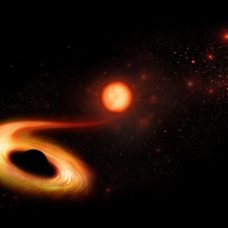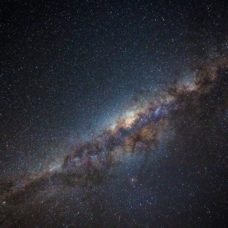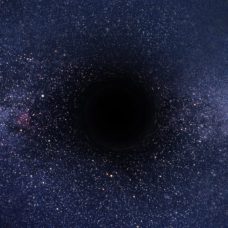Measuring the distances between cosmic bodies in space led us to some big discoveries, such as universal expansion. The H0LiCOW collaboration of scientists measured a lensed quasar to determine a new Hubble Constant. Their findings may uncover new physics.
The Hubble Constant
In the late 1920s, astronomer Edwin Hubble was studying the apparent speed of galaxies in the observable universe. Hubble noticed that the farthest galaxies seemed to move faster, so he endeavored to calculate the rate of expansion.
Later called the Hubble Constant, Hubble’s observations led to a constant which quantifies this expansion of the universe. For nearly a century, the Hubble Constant has been refined with increasingly efficient telescopes and more sensitive instruments that better determined the size and age of the universe.
Quasars: A new Measurement of the Hubble Constant
The H0LiCOW collaboration carried out a new measurement of the Hubble Constant. The team exploited a cosmic phenomenon called “gravitational lenses” in which the enormous mass of galaxies curves space-time. Scientists used the Hubble Space Telescope and other space and Earth-based telescopes to study light from three galaxies. Their work is published in five papers in the Monthly Notices of the Royal Astronomical Society.
Galaxies act as lenses and bend light from quasars located much farther away. Quasars are the regions surrounding supermassive black holes. They are created when the core of a surrounding galaxy falls under the influence of the black hole, thereby emitting enormous amounts of electromagnetic energy.
The mass of these galaxies is not evenly distributed, making some areas bend light more than others. As a result, light from quasars will arrive at slightly different times. By analyzing the delay, researchers could arrive at a measurement for the Hubble Constant.
The Max Planck Institute lead H0LiCOW team determined an accurate Hubble Constant by measuring three things. First, the mass distribution from quasar to telescope along the line of sight. Next, the team measured the delay of light and the mass distribution of the lens galaxy.
#H0LiCOW scientists measured a new #HubbleConstant from bent #quasar light.Click To TweetA new Wrinkle in Time, Physics
This new measurement differs from some and agrees with others. The H0LiCOW collaboration estimate of the Hubble Constant (71.9±2.7 kilometers per second per megaparsec) is close to the most recent measurements using Cepheids and supernovae. But it differs significantly from the measurement made with the Planck telescope in 2015.
Chriss Fassnacht, a physics professor at UC Davis and H0LiCOW member, said “If you still see something when the error bars shrink, maybe it’s new physics, beyond the Standard Model of cosmology.”
This discrepancy in the Hubble constant estimates could reflect something that astronomers do not yet understand about the birth of the universe or something that would have changed since that time.
It may well be that the dark energy–thought to be the driving force of the expansion of the universe-is increasingly strong. It could indicate that dark matter may have unknown characteristics, or that it does not exist at all. These sorts of experiments get us closer and closer.



















Interesting read. Are we not living in a Multiverse?
From Astrogeometry here is the equation to calculate Hubble’s Constant, by inputting to an equation, the numerical value of Pi and the speed of light (C) from Maxwell’s equations, and the value of a parsec. NO space probe measurements (with their inevitable small measuring / interpretation errors) are now required. Hubble’s Constant is ‘fixed’ at 70.98047 PRECISELY. This maths method removes the errors / tolerances that is always a part of attempting to measuring something as ‘elusive’ as Hubble’s Constant. This has very deep implications for theoretical cosmology due to the fact its reciprocal is 13.778 BLY’s, and is the Hubble Horizon Distance, NOT the age of the universe, as it does not increase with time. The equation to perform this is 2 X a meg parsec X light speed (C). This total is then divided by Pi to the power of 21. This gives 70.98047 kilometres per sec per meg parsec. The equation to perform this can also be found in ‘The Principle of Astrogeometry’ on Amazon Kindle Books. This also explains how the Hubble 70.98047 ‘fixing’ equation was found. David.